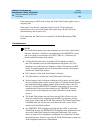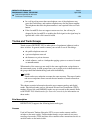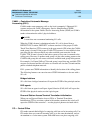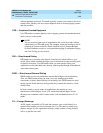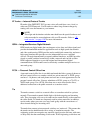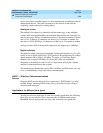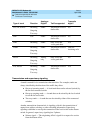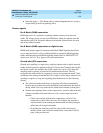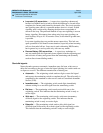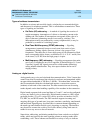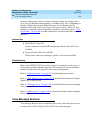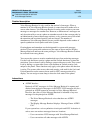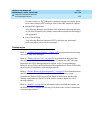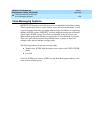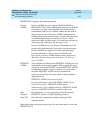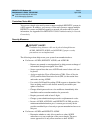
DEFINITY ECS Release 8.2
Administrator’s Guide
555-233-506
Issue 1
April 2000
Features and technical reference
1571Trunks and Trunk Groups
20
■ Loop-start (LS) supervision — A supervisory signaling scheme used
between a telephone and a switch in which the telephone or far-end office
completes the current path formed by the trunk wires. The circuit provides
one signaling state when it is open and another when it is closed. A third
signaling state is achieved by changing the direction or magnitude of
current in the loop. The preferred method of loop-start signaling is reverse
battery signaling. Disconnect times when using loop-start signaling can
result in delays of up to 10–20 seconds. Glare, as described in ground-start,
is possible.
Loop-start signaling does not provide answer supervision. This lack can
open a potential for toll fraud in some situations, especially when incoming
calls are forwarded off-net. Loop-start is used with analog DIOD trunks,
but in general try to use loop start only with one-way trunks.
■ Reverse Battery (RB) supervision — A supervisory technique on
one-way trunks that uses open and closure signals from the originating end
and reversals of battery and ground from the terminating end (normally
used on direct inward dialing trunks).
Start-dial signals
Network trunks operate as automatic, immediate start, dial tone, wink start, or
delay dial according to the type of start-dial signal (alerting) the switch sends out
or expects to receive. The different transmissions of alerting are:
■ Automatic — The originating switch sends no digits or start dial signal
and expects the terminating switch to complete the call. The call usually is
completed by the attendant or other service such as Centralized Attendant
Service (CAS).
■ Immediate start — The originating switch sends digits immediately
without waiting for a start dial signal from the terminating switch.
■ Dial tone — The terminating switch sends precise dial tone to the
originating switch. This indicates that the terminating switch is ready to
receive digits.
■ Wink start — The terminating switch sends a wink start (momentary
off-hook) signal to the originating switch. This indicates that the
terminating switch is ready to receive digits.
■ Delay dial — The terminating switch sends a delay dial signal (an
off-hook signal followed by an on-hook signal) to the originating switch.
This indicates that the terminating switch is ready to receive digits.



